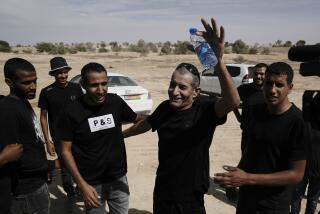Most Jews Out of Gaza, Israel Says
ATZMONA, Gaza Strip — Israel declared Sunday it had finished evacuating Gaza’s principal block of Jewish settlements, a mainly peaceful process that left one isolated enclave to be emptied.
But confrontation loomed at two small settlements in the northern West Bank, where hundreds of ultranationalist Jewish youths, some of them heavily armed, had converged in recent days. They engaged in scattered clashes Sunday with troops preparing to start evacuations there this week.
Several senior security officials were quoted by Israeli media as saying they expected the removal of militants from the northern West Bank settlements of Homesh and Sanur to be far more difficult and dangerous for police and soldiers than was Thursday’s confrontation between Israeli forces and protesters at the settlement of Kfar Darom, the most violent clash so far in Gaza.
Finishing the clearing of Gaza’s main settlement block of Gush Katif marked another milestone for security forces engaged in Israel’s largest noncombat military operation ever. The evacuation of Gaza’s 21 settlements, which were home to 8,500 Jews, and four small enclaves in the West Bank began last week.
“I can declare Gush Katif empty of residents,” Avi Zelba, a spokesman for the Israeli police, said Sunday night after the settlements of Slav, Katif and Atzmona were secured by troops. The soldiers will remain in place for several weeks before Gaza is handed over to the Palestinian Authority.
The only remaining Gaza settlement to be evacuated was Netzarim, a remote community of at least 500 people. Israeli reports said its residents had agreed to offer only passive resistance when police and soldiers headed in today.
Earlier, acrid black smoke from a burning barricade poured into the air as troops arrived at Atzmona. But settlers and their supporters eventually agreed to depart after a solemn ceremony at the local synagogue.
For more than an hour, the soldiers and settlers sang together.
Israeli forces also began in earnest the job of knocking down homes in several Gaza settlements. Clouds of dust and debris rose as bulldozers tore into dozens of houses, some still containing scattered toys and books.
Israelis and Palestinians had agreed beforehand that the settlers’ single-family homes would not meet housing needs in crowded Gaza. The Palestinian Authority has said it will build high-rise apartment buildings on some of the settlement land.
Hundreds of settlers left quietly Sunday, though rarely without first remonstrating with the young troops. In Atzmona, the automatic sprinkler system was still watering lawns when the soldiers arrived, and a young girl mopped the entryway to a home.
“Everything we did was done for God,” said Rabbi Nachum Rachel, father of 13 children. The Rachel family had been uprooted 23 years earlier from the Jewish settlement of Yamit, in the Sinai peninsula, after Israel made peace with Egypt.
Settlers sought to remind Israelis as a whole that although many soldiers died defending their fortified communities, they had suffered great losses of their own. Katif, one of the settlements emptied Sunday, was home to the Hatuel family, all but wiped out in a shooting attack last year by Palestinian militants while traveling to Israel.
At the family home, memorial candles flickered and five empty chairs were marked with the names of Tali Hatuel and her four daughters, plus the baby she had carried nearly to term. David Hatuel, the father and the family’s only surviving member, was surrounded by weeping friends and neighbors.
Tali Hatuel had taken her children, all 11 and younger, to campaign against a referendum being held that day by voters in Israeli Prime Minister Ariel Sharon’s Likud Party on whether to proceed with the pullout.
In Atzmona, arriving soldiers were greeted by the sight of a mock cemetery for enemies of the Jewish people, complete with cardboard tombstones emblazoned with names such as Yasser Arafat and Adolf Hitler.
Its builders broadly hinted that an open “grave” and a blank tombstone were designated for Sharon, who has been the target of many death threats in the months leading up to the pullout.
Evacuating troops faced another trying task Sunday: chasing down protesters from the West Bank who had made squatters’ nests in abandoned settler homes. Trenches were being dug around some of the settlements to try to keep out Israeli infiltrators.
Israeli leaders Sunday were still expressing shock over the violent turn the evacuation took last week when militant Jewish youths, mainly from outside Gaza, made a last stand on the rooftop of a synagogue in Kfar Darom. The youngsters pelted unarmed soldiers and riot police with paint, rocks and paint thinner, and used sharp poles to try to repel them.
Sharon, addressing his Cabinet, described such resistance as “wild acts that I think border on crimes,” according to Israeli media reports.
Despite last week’s violence, the pullout from Gaza has gone much quicker and relatively smoother than anticipated. Military leaders initially said they expected the emptying of the Gaza settlements to take weeks.
Simhi reported from Atzmona and King from Jerusalem.
More to Read
Sign up for Essential California
The most important California stories and recommendations in your inbox every morning.
You may occasionally receive promotional content from the Los Angeles Times.










